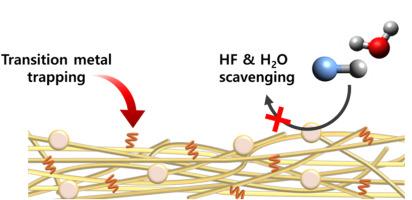多重扫气功能分离器,确保高能量密度锂离子电池循环稳定
IF 7.9
2区 工程技术
Q1 CHEMISTRY, PHYSICAL
引用次数: 0
摘要
富镍LiNixCoyMn1-x-yO2 (NCM)材料是实现锂离子电池(LIBs)高能量密度的关键正极活性材料。然而,它们的实际应用受到界面和结构不稳定性的阻碍,如微开裂、过渡金属溶解和阴极表面电解质的氧化分解,这些会导致电池电阻增加和性能下降。在循环过程中,杂质(如H2O、HF和过渡金属)的寄生反应加剧了这些问题。在本研究中,我们制备了一种含有沸石的接枝聚丙烯腈膜(GPANZ)作为多清除功能分离器,以提高锂离子电池的循环性能。GPANZ由去除H2O和hf的功能沸石和过渡金属螯合功能聚乙烯亚胺组成,可有效捕获细胞内的各种杂质。因此,GPANZ分离器可以通过抑制杂质的有害影响来减轻电极和电解质的降解。采用GPANZ隔膜制备的石墨/LiNi0.8Co0.1Mn0.1O2电池在放电容量、循环寿命和倍率性能方面表现出优异的循环性能,特别是在高温下。我们的工作强调了去除杂质以确保电池性能的必要性,并为设计锂离子电池的功能分离器提供了新的见解。本文章由计算机程序翻译,如有差异,请以英文原文为准。

Multi-scavenging functional separator ensuring the cycling stability of high energy density lithium-ion batteries
Ni-rich LiNixCoyMn1-x-yO2 (NCM) materials are key cathode active materials for achieving high energy densities in lithium-ion batteries (LIBs). However, their practical applications are hindered by interfacial and structural instabilities such as microcracking, transition metal dissolution, and oxidative decomposition of the electrolyte at the cathode surface, which cause an increase in cell resistance and performance degradation. These problems are exacerbated by the parasitic reactions of impurities, such as H2O, HF, and transition metals during cycling. In this study, we fabricate a grafted polyacrylonitrile membrane containing zeolite (GPANZ) as a multi-scavenging functional separator to improve LIB cycling performance. GPANZ consists of H2O- and HF-removing functional zeolite and a transition-metal-chelate functional polyethyleneimine, thus effectively capturing various impurities in the cell. Therefore, the GPANZ separator can mitigate electrode and electrolyte degradation by suppressing the deleterious effects of impurities. The graphite/LiNi0.8Co0.1Mn0.1O2 cell with the GPANZ separator exhibits superior cycling performance in terms of discharge capacity, cycle life, and rate performance, especially at high temperatures. Our work highlights the necessity of removing impurities to ensure battery performance and provides new insights for designing functional separators for LIBs.
求助全文
通过发布文献求助,成功后即可免费获取论文全文。
去求助
来源期刊

Journal of Power Sources
工程技术-电化学
CiteScore
16.40
自引率
6.50%
发文量
1249
审稿时长
36 days
期刊介绍:
The Journal of Power Sources is a publication catering to researchers and technologists interested in various aspects of the science, technology, and applications of electrochemical power sources. It covers original research and reviews on primary and secondary batteries, fuel cells, supercapacitors, and photo-electrochemical cells.
Topics considered include the research, development and applications of nanomaterials and novel componentry for these devices. Examples of applications of these electrochemical power sources include:
• Portable electronics
• Electric and Hybrid Electric Vehicles
• Uninterruptible Power Supply (UPS) systems
• Storage of renewable energy
• Satellites and deep space probes
• Boats and ships, drones and aircrafts
• Wearable energy storage systems
 求助内容:
求助内容: 应助结果提醒方式:
应助结果提醒方式:


